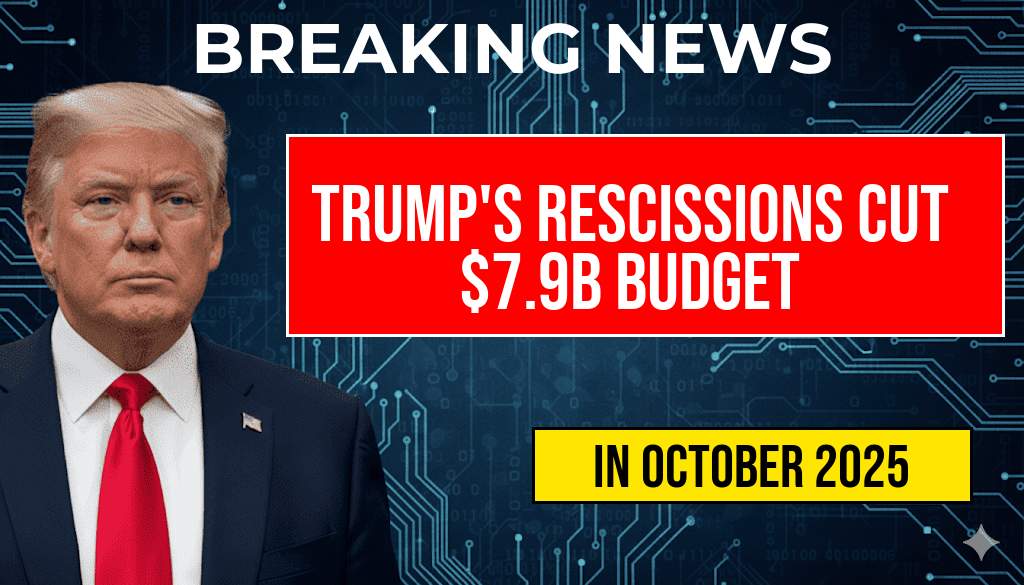President Donald Trump’s recent Rescissions Act has resulted in a significant reduction of the federal budget by approximately $7.9 billion. This move, signed into law earlier this month, aims to cut discretionary spending across various government agencies, reflecting the administration’s focus on fiscal conservatism and budget discipline. The rescission package, approved by Congress through expedited procedures, targets unspent funds from previous fiscal years, reallocating resources or canceling allocations considered surplus or unnecessary. While proponents argue that the measure promotes responsible government spending, critics warn it could hinder ongoing projects and federal operations, especially amid ongoing economic uncertainties. The impact of this substantial budget reduction will unfold over the coming months as agencies adjust their programs and priorities in response to the tighter fiscal constraints.
Background and Legislative Process
The Rescissions Act is a legislative tool that allows the President to propose the cancellation of unspent funds from prior appropriations. Its use is relatively rare and requires bipartisan approval in Congress. The recent act was introduced as part of the Trump administration’s broader strategy to curb federal spending and reduce the national deficit. The process involved a swift legislative journey, with the House of Representatives and Senate passing the measure through expedited procedures, bypassing lengthy debate in favor of a quicker approval process. This approach aligns with the administration’s emphasis on efficiency and fiscal restraint, especially during a period of economic recovery following the COVID-19 pandemic.
Scope of the Budget Reduction
| Agency/Program | Amount Affected (in billions) | Notes |
|---|---|---|
| Department of Defense | $2.3 billion | Unspent funds from military construction projects |
| Department of Health and Human Services | $1.5 billion | Research grants and public health programs |
| Department of Education | $1.0 billion | Student aid and educational grants |
| Environmental Protection Agency | $0.8 billion | Research and environmental cleanup projects |
| Other Agencies | $2.3 billion | Various smaller programs and initiatives |
The total of $7.9 billion encompasses a broad spectrum of government activities, with the Department of Defense and health-related programs seeing the largest cuts. The rescission primarily affects funds that agencies had not yet allocated or spent, raising concerns about potential impacts on ongoing initiatives and future planning.
Reactions from Lawmakers and Stakeholders
Supporters’ Perspectives
Supporters, including many Republicans, argue that the Rescissions Act exemplifies prudent fiscal management. Rep. Kevin McCarthy, House Minority Leader, stated, “This measure helps us tighten the federal budget and ensures taxpayer dollars are used efficiently.” They contend that reducing unspent funds prevents waste and signals a commitment to controlling government growth amid a challenging economic environment.
Critics’ Concerns
Democrats and advocacy groups warn that the cuts could undermine critical services. Senator Patty Murray, ranking member of the Senate Health, Education, Labor, and Pensions Committee, expressed concern that rescinding funds for health and education programs might delay vital research and public health initiatives. Critics also caution that the impact on military construction projects could affect readiness and infrastructure development.
Economic and Policy Implications
The immediate effect of the $7.9 billion budget reduction is a tightening of federal spending, which may influence ongoing projects and future planning. While some analysts view the move as a step toward fiscal responsibility, others warn that it could slow down economic activity in sectors reliant on federal funding. The rescission also reflects broader debates about government size, efficiency, and the appropriate level of federal intervention in various policy areas.
Looking Ahead
Implementation of the rescission provisions will require agencies to reassess their budgets and project timelines. Some programs might face delays or reductions, which could ripple through local economies and industry sectors dependent on federal contracts. Congressional oversight committees are expected to monitor how agencies adapt to these changes and whether further rescissions or spending adjustments are warranted.
Additional Resources
- Federal Budget in the United States – Wikipedia
- Forbes – Trump’s Rescissions Act Cuts $7.9 Billion from Federal Budget
Frequently Asked Questions
What is the main purpose of Trump’s Rescissions Act?
The main purpose of Trump’s Rescissions Act is to reduce the federal budget by seven point nine billion dollars through rescinding allocated funds that are no longer needed or deemed unnecessary.
How much budget does the Rescissions Act aim to cut?
The Rescissions Act aims to cut a total of seven point nine billion dollars from the federal budget.
Which areas or programs are affected by the rescissions?
The rescissions primarily target specific federal programs and funding allocations that have been identified as surplus or unnecessary, though the article details specific programs affected.
What are the potential impacts of the budget reduction?
The budget reduction could impact government operations, public services, and project funding depending on which areas experience the rescission of funds.
When was the Rescissions Act implemented?
The Rescissions Act was enacted recently, as part of Trump’s efforts to manage and reduce federal spending in the current fiscal cycle.






